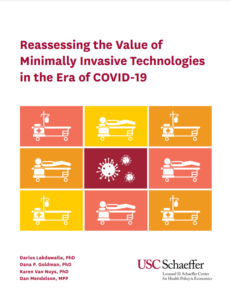Over the past year, COVID-19 surges created hospital capacity crises as hospitalizations rose to unprecedented levels. Limited surge capacity forced hospitals into difficult decisions, including canceling scheduled elective surgeries, transferring ICU patients to step-down units sooner, limiting admittance to the emergency department and increasing the number of patients assigned to a single nurse.
Minimally invasive technologies are just one example of capacity-conserving healthcare that can reduce burdens on providers and hospitals while shielding patients from unnecessary exposure to infection. Yet these valuable strategies and technologies are underutilized when payment formulas emphasize bed volume and more labor-intensive procedures.
 A new white paper published by the Schaeffer Center analyzes why the COVID-19 pandemic, with hospitals filled to capacity, presents an opportunity to re-think our use of minimally invasive technologies.
A new white paper published by the Schaeffer Center analyzes why the COVID-19 pandemic, with hospitals filled to capacity, presents an opportunity to re-think our use of minimally invasive technologies.
“We are learning how vulnerable U.S. healthcare systems are to widespread prevalence of a highly transmissible disease, and sudden surges in local demand for specific healthcare resources such as ventilators and ICU beds,” says Darius Lakdawalla, director of research at the Schaeffer Center. “Hospital capacity-conserving strategies will be important for the remainder of this pandemic and future events that threaten to overwhelm hospital resources.”
Delayed or Forgone Healthcare Amidst COVID-19
Limited hospital capacity and fears of contagion have led patients to postpone or forego high-value preventive care and procedures, creating direct and indirect health and economic costs that will last well beyond the current pandemic.
Recent studies show preventive care like mammograms and colonoscopies, and elective procedures such as cataract removals, declined significantly in the early weeks of the pandemic.
Minimally Invasive Technologies Could Reduce Capacity Constraints and Contagion Fears
Lakdawalla and colleagues focused on minimally invasive technologies as an alternative to get more out of existing healthcare capacity. For many procedures, ranging from lumbar fusions to appendectomies, minimally invasive approaches are typically associated with less pain, shorter hospital stays and fewer complications.
For example, patients undergoing a cardiac valve repair surgery performed with a minimally invasive technology had, on average, a 55% shorter hospital stay compared to patients undergoing the same surgery using traditional methods. This “saved” capacity could be used to increase hospital revenues by treating more valve repair patients, but it could also be used as surge capacity for additional COVID-19 patients.
Shorter hospital stays also mean less exposure to infectious pathogens and a decreased likelihood of being discharged to a nursing home.
Reformed Reimbursement Policies Would Encourage Technology Use
The researchers conclude that while COVID-19 is the most recent example of a novel infectious disease causing a global pandemic, it will not be the last, so policy should support investment in minimally invasive technologies that can expand hospital surge capacity.
Hospitals currently face several barriers to adopting these technologies. Volume-based reimbursement rules ensure that hospitals make more money when beds are full. If minimally invasive technologies are employed to create surge capacity, hospitals will lose money on the empty beds, even though that capacity is serving a valuable purpose.
Reimbursement for overhead drives much of hospitals’ contribution margins. Procedures that require longer hospital stays involve higher charges for per-diem items like personnel labor and room and board, which in turn permit higher overhead charges. As a result, hospitals face disincentives to adopt technologies that shorten hospital stays.
Many minimally invasive procedures involve highly innovative and sometimes expensive technologies and devices. Much of the reimbursement for such procedures is passed through to the technology provider. Combined with the lower overhead associated with shorter hospital stays, this tends to limit hospital profitability on minimally invasive procedures.
Finally, certain practice requirements serve to raise the costs of minimally invasive procedures without providing commensurate benefit.
“These technologies have value that historically has not been taken into account when considering reimbursement policy,” explains Karen Van Nuys, executive director of the Value of Life Sciences Innovation Program at the Schaeffer Center. “The reduced medical expenditures resulting from shorter hospitalizations and fewer complications are typically considered when determining reimbursement for these technologies. But their ability to increase surge capacity and reduce patients’ fear of contagion during a pandemic like COVID-19 are not.”
Policymakers should review these and other policies and the incentives they create for hospitals to invest in minimally invasive technologies. At the same time, support for such technologies could be tailored to help address existing health disparities.
Funding for this study was provided by the Schaeffer Center for Health Policy & Economics, which is supported by a wide variety of public and private entities including companies that develop minimally invasive technologies.

You must be logged in to post a comment.